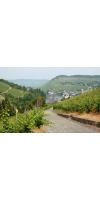Wine from Richard Bocking

The Weingut Richard Bocking Winery
Our story embraces Classic Viticulture on the steep slopes of the Mosel River Valley with a 15-generation family tradition.
The extremely steep, slate-laced hillsides in the central region of the Mosel River offer optimal conditions for producing great Riesling wines. Since 1624 the Böcking Family has been devoted to producing wines of the highest quality – crisp, fruity wines that are the finest a Riesling enthusiast could desire.
The roots of the Böcking family can be traced to the early 17th Century, when the family was appointed regional treasurer under Prince Pfälz-Zweibrücken. Soon thereafter, the family became active in the budding wine production and trading business in Trarbach, purchasing what may be the oldest Riesling vineyard on the Mosel, the Trabacher Ungsberg. The Trarbacher Schlossberg vineyard was acquired soon thereafter.
The Böcking family has lived, loved and passed down the tradition of winemaking, along with portions of four steep-slope vineyards, to successive generations. It is their experience and dedication, combined with decades-old vines growing on rich, mineral soils, that allow the family to continue to produce the finest Mosel Riesling wines.
Recently, Denman Zirkle and daughter Sigrid Carroll, a direct descendant of Richard Böcking purchased the Estate from a cousin, Wolf von Marschall. Denman, along with his daughter, Sigrid Carroll, Wolf’s sister, Leweke von Marschall, and the winegrower, Simon Trös, combined tradition and history with confidence and entrepreneurial vision to lead the family enterprise into the future and reestablish its international following. Their focus is on natural viticulture and production, developing mostly drier Riesling wines to suit contemporary tastes in Germany and abroad.
In 2013, after almost 400 years, Böcking wines were introduced to the U.S. market for the first time. Importation into the United Kingdom began the following year.
In Germany, Böcking wines are being distributed by several large merchants, including Weinkontor Freund ( http://www.weinkontor-freund.de ), one of the largest in Germany. Freund serves over 2,000 restaurants and retail clients, many high end. Until 2014, Freund specialized in wines from Italy, France, Spain and Portugal. When he added Germany in 2014, Richard Böcking is the only winery on the Mosel he chose to represent."
In the United States, Böcking is represented by importer Kysela Pere et Fils, named Importer of the Year in 2013 by Wine Enthusiast magazine. The wines are currently being distributed in the Mid-Atlantic states, District of Columbia, and Montana. Please click here see where to purchase our wines.
The Weingut Richard Bocking Vineyards
The character of the wines is shaped by the distinctive Grand Cru, steep slope vineyards of which Richard Böcking has 15 acres under cultivation. The plantings are 95% Riesling and 5% Spätburgunder (Pinot Noir). Of the five vineyards: Ungsberg, Burgberg, Schlossberg, Huenerberg and Taubenhaus, four are classified as Grand Cru with vintage vines up to 80 years old. The age of the vines force the roots of these grape vines deep into the ground for water and nutrition. Thus, the vines are constantly absorbing their nutrition, even during unseasonably dry periods. The constant nourishment provides vines that are strong, disease resistant, and produce small, compact grapes with an unusual concentration of fruit.
Richard Böcking develops their wines by hand, from the vineyard to the bottle. Unadulterated; with an originality that can be produced only in a natural vineyard environment. From this tenet springs Böcking's fundamental philosophy—a philosophy of allowing a wine to develop naturally. In the steep-slope vineyards, this philosophy means the small vineyard parcels are cultivated individually and by hand. All wines are developed as bio-dynamically as possible, using naturally occurring yeast and introducing only the sparest amount of sulfur. This meticulous attention to natural agriculture and production creates beautifully finished wines while sustaining the vineyards for the future.
No products found
- back
Selected Options
Wineries
Categories
Pricing
Countries
Regions
Grape Types
Wineries
Organic/Free Shipping
All older vintage wines have been purchased from a single collectors cellar. Pictures can be requested before shipment.
A complex Carignan mixing black fruits and spices. Intense color and fine structure with rounded tannins and volume in the mouth.
RS: 2g/L
The fruit was carefully sorted to ensure only healthy, ripe grapes were vinified. Traditional fermentation took place in stainless steel tanks at controlled temperatures of 28°C with selected yeasts. Remontage or pump overs took place periodically to oxygenate the wine and extract tannins. A short post-fermentation maceration took place to extract color, flavor and impart structure to the wine. Ageing in stainless steel preserved the integrity of the pure fruit character. The wine was lightly filtered before bottling.




